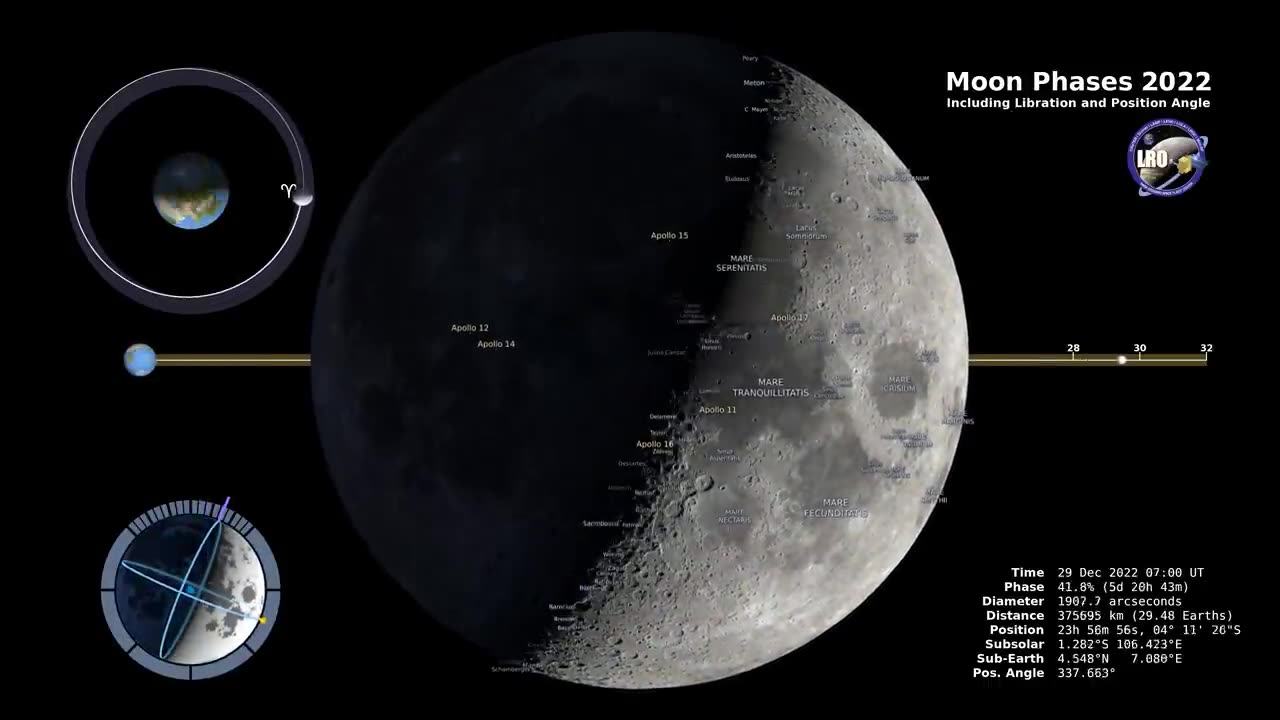Premium Only Content

NASA moon phases 2022 northern hemisphere 4K
Certainly! The moon goes through a cycle of different phases as it orbits the Earth. These phases are the result of the changing relative positions of the Earth, moon, and sun. Here's a description of the main moon phases in the northern hemisphere:
New Moon: During a new moon, the moon is positioned between the Earth and the sun, with its dark side facing us. As a result, the side of the moon that's illuminated by the sun is facing away from Earth. This phase is not visible from Earth, as the illuminated side is facing away.
Waxing Crescent: In the days following the new moon, a small sliver of the moon becomes visible in the western evening sky. This is the waxing crescent phase. The illuminated portion is gradually increasing, resembling a crescent shape. It's a good time for observing faint stars and planets in the vicinity of the moon.
First Quarter: About a week after the new moon, the moon reaches its first quarter phase. This means that half of the side facing Earth is illuminated, creating a half-moon shape. The first quarter moon is visible in the evening sky and is often seen high in the southern sky.
Waxing Gibbous: As the moon continues to orbit the Earth, the illuminated portion gradually expands. This phase is called the waxing gibbous. It appears as a large portion of the moon's surface being illuminated, but it's not yet completely full.
Full Moon: The full moon occurs when the moon is directly opposite the sun, with Earth in between. This results in the entire side facing Earth being fully illuminated. Full moons are bright and easily visible, often lighting up the night sky. They are also associated with cultural and traditional events.
Waning Gibbous: After the full moon, the moon enters the waning phase. The illuminated portion begins to shrink, starting with the waning gibbous phase. It looks similar to the waxing gibbous but with the illuminated area gradually decreasing.
Last Quarter: Around a week after the full moon, the moon reaches its last quarter phase. Half of the side facing Earth is illuminated, just like in the first quarter phase, but now the illuminated side is on the left. The last quarter moon is visible in the morning sky and is often seen high in the southern sky.
Waning Crescent: In the final stages of the moon's cycle, the illuminated portion continues to decrease, forming the waning crescent phase. The crescent shape becomes thinner and thinner until it becomes too faint to see as the new moon approaches once again.
These phases repeat in a predictable cycle as the moon orbits the Earth. Keep in mind that the visibility of each phase can be affected by factors such as atmospheric conditions, light pollution, and your specific location on Earth.
-
 LIVE
LIVE
MyronGainesX
15 hours ago $3.43 earnedICE Riots, Diddy Trial, Weinstein Retrial Conviction, Middle East War Tensions Rise!
2,175 watching -
 LIVE
LIVE
Sarah Westall
58 minutes agoPDiddy Trial Exposes Domestic Violence while Protecting Deeper Corruption w/ Attorney Joe Nierman
163 watching -
 LIVE
LIVE
Athlete & Artist Show
6 hours agoStanley Cup Final WATCH PARTY
76 watching -
 LIVE
LIVE
SpartakusLIVE
2 hours agoAre they really going to end WZ?? || Duos w/ @GloryJean
165 watching -
 LIVE
LIVE
Tundra Tactical
35 minutes agoAntigun Groups Are HIDING the Truth from You!
75 watching -
 LIVE
LIVE
Josh Pate's College Football Show
5 hours agoCFB’s Big Changes | SEC Schedule Release | Big Ten QB Rankings | Honeymoon Takeaways
59 watching -
 LIVE
LIVE
AirCondaTv Gaming
2 hours agoJump Ship: Demoing in Space with JFG & the Gang (Collab)
40 watching -
 LIVE
LIVE
The Daily Signal
1 hour ago🚨 BREAKING: ISRAEL CURRENTLY STRIKING IRAN
370 watching -
 LIVE
LIVE
GloryJean
1 hour ago#1 Gamer Dad Dominates on MnK 🖱️
20 watching -
 LIVE
LIVE
BSparksGaming
43 minutes agoKoopa w/ the Dubs! Mario Kart World Online Multiplayer
18 watching